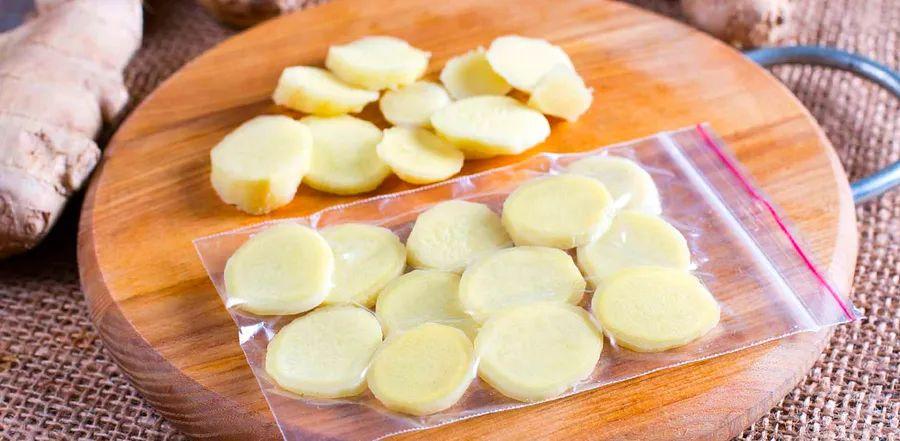3 Easy Ways to Freeze Fresh Ginger for Long-Term Storage

Few ingredients are as distinct in both flavor and aroma as ginger. Its fiery, spicy, and juicy essence adds a vibrant kick to any dish it graces.
Though ginger is technically a root and might seem like it has a long shelf life (up to 2 to 3 weeks when stored at room temperature or in the fridge), those weeks tend to pass by quicker than expected, especially for those who handle the shopping and meal prep.
That brief window of time can easily slip by, especially if your ginger ends up forgotten in the fridge. However, freezing ginger preserves its freshness and flavor for the long haul, so you can enjoy it for months.
How to Choose and Prep Ginger for Freezing
Freezing ginger is a breeze. No need for any special expertise or rushing to click "add to cart" – all you need is a sharp knife, some plastic wrap, a freezer-safe zip-top bag or airtight container, and a marker. If you want to prep the ginger more finely, you may want to use a food processor or blender.
The best ginger for freezing is fresh — not the kind that's already wilting, wrinkled, or dried out. Fresh ginger is firm, plump, smooth (between the knobs), and bursting with a fragrant, zesty aroma. This is the kind of ginger that will freeze well and maintain its flavor.

Get the recipe: Big Soft Ginger Cookies
Step-by-step Guide for Freezing Ginger
There are three main methods for freezing ginger: you can freeze it pureed, chopped, or whole, depending on your recipe requirements and how much time you have.
Pureed Ginger
To puree ginger, peel it (or leave the skin on) and place it in a food processor or high-powered blender (if unpeeled, you may need to blend it a bit longer). Once pureed, spoon the mixture into an ice cube tray and freeze. After freezing, transfer the cubes to a zip-top bag to prevent freezer burn. Don’t forget to label and date the bag.
For a looser puree, gradually add water until you reach the desired consistency. Then, pour it into the ice cube tray and freeze as you would the paste.
Alternatively, you can portion the puree into zip-top bags, flatten them out, press out as much air as possible without squeezing the puree, seal, label, and freeze the bags flat on a sheet pan lined with parchment paper or paper towels.
Cut Ginger
Peel and slice the ginger into the portions you commonly use in your cooking. For instance, if your recipes often call for grating a 1-inch piece of ginger, peel the whole root and cut it into 1-inch sections.
Place the cut pieces in a zip-top bag or container, remove as much air as possible if using a bag, seal it, and label it. Labeling helps you identify what's inside later, especially when you’ve forgotten just how prepared you were at the time.
If you prefer minced ginger, go ahead and chop it up. It takes a little extra time, but it will save you valuable prep time later. After mincing, put the ginger in a zip-top bag, press it flat, seal, and label it.
Whole Ginger
Whether you peel your ginger before freezing it whole is completely your choice. There’s no noticeable difference in flavor or texture whether you leave the skin on or remove it, but if you prefer to peel it or are concerned about the texture, feel free to do so beforehand.
Wrap the entire piece of ginger securely in plastic wrap, then place it in a zip-top bag or airtight container. Seal, label, and it's ready for the freezer.
Best Practices for Storing Frozen Ginger
For optimal flavor, try to use your frozen ginger within 6 months. While it won't go bad after that, it will lose much of its fresh taste.
Always use freezer-safe bags or containers. These will help keep your ginger fresh longer by sealing in its flavor and keeping out any unwanted odors.
Potential Uses for Frozen Ginger
Frozen ginger can be grated directly from the freezer without needing to thaw it. Just peel and grate as you normally would. And if you don't use all of it, you can easily return the leftover ginger to the freezer.
Pro tip: A spoon works wonders for peeling frozen ginger. It’s a great method when the ginger is fresh, but even better when it's frozen. While a peeler or knife can work on fresh ginger, it’s nearly impossible once it’s frozen. Grated frozen ginger is perfect for adding to sauces and cocktails.

Get the recipe: Ginger Veggie Stir-Fry
If your recipe requires sliced ginger, make sure to thaw it first. While grating frozen ginger is a breeze (often easier than using fresh), slicing it with a knife can be tricky and even dangerous. Microwave it for about 15 seconds before cutting it.
If you've pre-sliced your ginger before freezing, let it thaw before using it in your dish. For frozen minced ginger, simply break off the amount you need, microwave it, and add it to your recipe.
Frozen ginger puree cubes are perfect for soups, braises, or stir-fries — just drop the cube right in. If you're using it for baking, let it come to room temperature first.
Evaluation :
5/5



